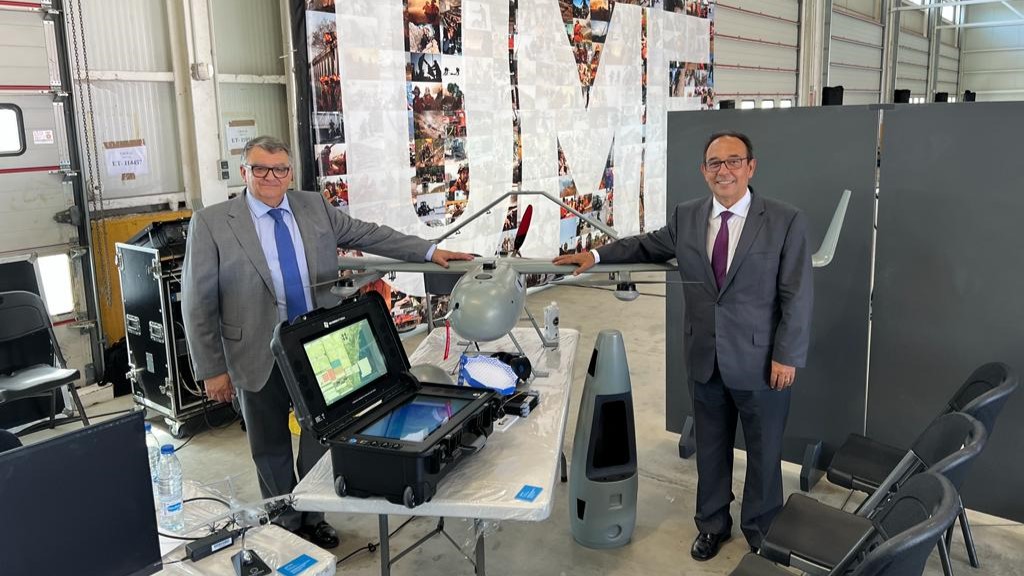The conference took place in April at the Torrejón de Ardoz Air Base (Madrid) in collaboration with the Subdirectorate General of Planning, Technology and Innovation of the Directorate General of Armament and Material at the UME Headquarters to enhance the capabilities of the UME in the use of drones in any operation and with specific high-tech capabilities.
Drones open a window of opportunity to enhance and improve the response to emergency situations, through the use of unmanned means that, in addition to providing new technological capabilities, contribute to the safety of the intervention and the protection of the affected population. In this scenario, the Military Emergency Unit (UME), in collaboration with the Subdirectorate General of Planning, Technology and Innovation (SDGPLATIN) of the Directorate General of Armament and Material (DGAM), recently organized a conference at the UME Headquarters at the Torrejón de Ardoz Air Base in Madrid, with the aim of creating a new technological capacity for the use of unmanned aerial vehicles in the response to emergency situations, in Madrid, with the aim of creating a specialized unit in the field of drones (Unidad de Drones de la UME, UDRUME), which will be responsible for enhancing the capabilities of the UME in this field, for use in any operational area and with specific high-tech capabilities.
The company IMSdrones, based at the Science Park of the University of Valencia (PCUV), participated in the conference, held in April, where it presented to both commanders and operators the information technology and ISR intelligence solutions it is working on. Specifically, an electric RPAS of three meters wingspan and less than 25 kilos of weight, its ground station and a command and control center for drones as a bet for the future.
The company offered airborne solutions for the UME to facilitate their work, especially in fire-related operations, which account for almost 70% of their operations. Early warning, surveillance and, especially, the combination or substitution of more costly aerial means and with greater risk for people, such as helicopters, represent a technological challenge in terms of flight, communications and surveillance of risk areas.
"Integrated solutions will be part of the aerial environment, whose final integration will culminate with U-Space, as a European regulatory framework for drones to facilitate the safe integration of drones in European airspace. It is a digital infrastructure that will enable automated and safe management of low altitude drone traffic in urban and rural areas.", Luis Vicente Galindo, CEO of IMSdrones
"ISR systems include high-resolution cameras, thermal cameras, radar systems, signal detection and target tracking systems. The data collected by these sensors can be processed to provide valuable information for decision making and operations planning," describes Luis Vicente Galindo, CEO of this ICT company located in the Parc Científic.
These aircraft are going to play a leading role in the immediate future in both civil and military fields, Galindo stresses. "Integrated solutions will be part of the aerial environment, whose final integration will culminate with the U-Space, as a European regulatory framework for drones that aims to facilitate the safe integration of drones in European airspace. It is a digital infrastructure that will allow the automated and safe management of low-altitude drone traffic in urban and rural areas," says the CEO of IMSdrones.
Within this regulatory framework, a drone command and control center is being developed by IMS in response to the growing number of drones operating in Europe's airspace, which seeks to ensure the safety and privacy of people on the ground, the integrity of operations and the ability to manage a large number of aircraft under a single operator, including technical and operational requirements for drones, operators and service providers, as well as for communication and coordination between them. "The incorporation of these aircraft to the UME will mean an improvement of these processes, providing them with more effective means for the improvement of their operations with all the social repercussions that it entails," concludes Galindo.
IMSdrones is developing a drone command and control center that seeks to ensure the safety and privacy of people on the ground, the integrity of operations, and the ability to manage a large number of aircraft by a single operator


